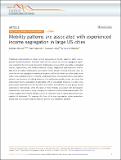Mobility patterns are associated with experienced income segregation in large US cities
Author(s)
Moro, Esteban; Calacci, Dan; Dong, Xiaowen; Pentland, Alex
DownloadPublished version (3.310Mb)
Publisher with Creative Commons License
Publisher with Creative Commons License
Creative Commons Attribution
Terms of use
Metadata
Show full item recordAbstract
<jats:title>Abstract</jats:title><jats:p>Traditional understanding of urban income segregation is largely based on static coarse-grained residential patterns. However, these do not capture the income segregation experience implied by the rich social interactions that happen in places that may relate to individual choices, opportunities, and mobility behavior. Using a large-scale high-resolution mobility data set of 4.5 million mobile phone users and 1.1 million places in 11 large American cities, we show that income segregation experienced in places and by individuals can differ greatly even within close spatial proximity. To further understand these fine-grained income segregation patterns, we introduce a Schelling extension of a well-known mobility model, and show that experienced income segregation is associated with an individual’s tendency to explore new places (place exploration) as well as places with visitors from different income groups (social exploration). Interestingly, while the latter is more strongly associated with demographic characteristics, the former is more strongly associated with mobility behavioral variables. Our results suggest that mobility behavior plays an important role in experienced income segregation of individuals. To measure this form of income segregation, urban researchers should take into account mobility behavior and not only residential patterns.</jats:p>
Date issued
2021Department
Massachusetts Institute of Technology. Media LaboratoryJournal
Nature Communications
Publisher
Springer Science and Business Media LLC
Citation
Moro, Esteban, Calacci, Dan, Dong, Xiaowen and Pentland, Alex. 2021. "Mobility patterns are associated with experienced income segregation in large US cities." Nature Communications, 12 (1).
Version: Final published version